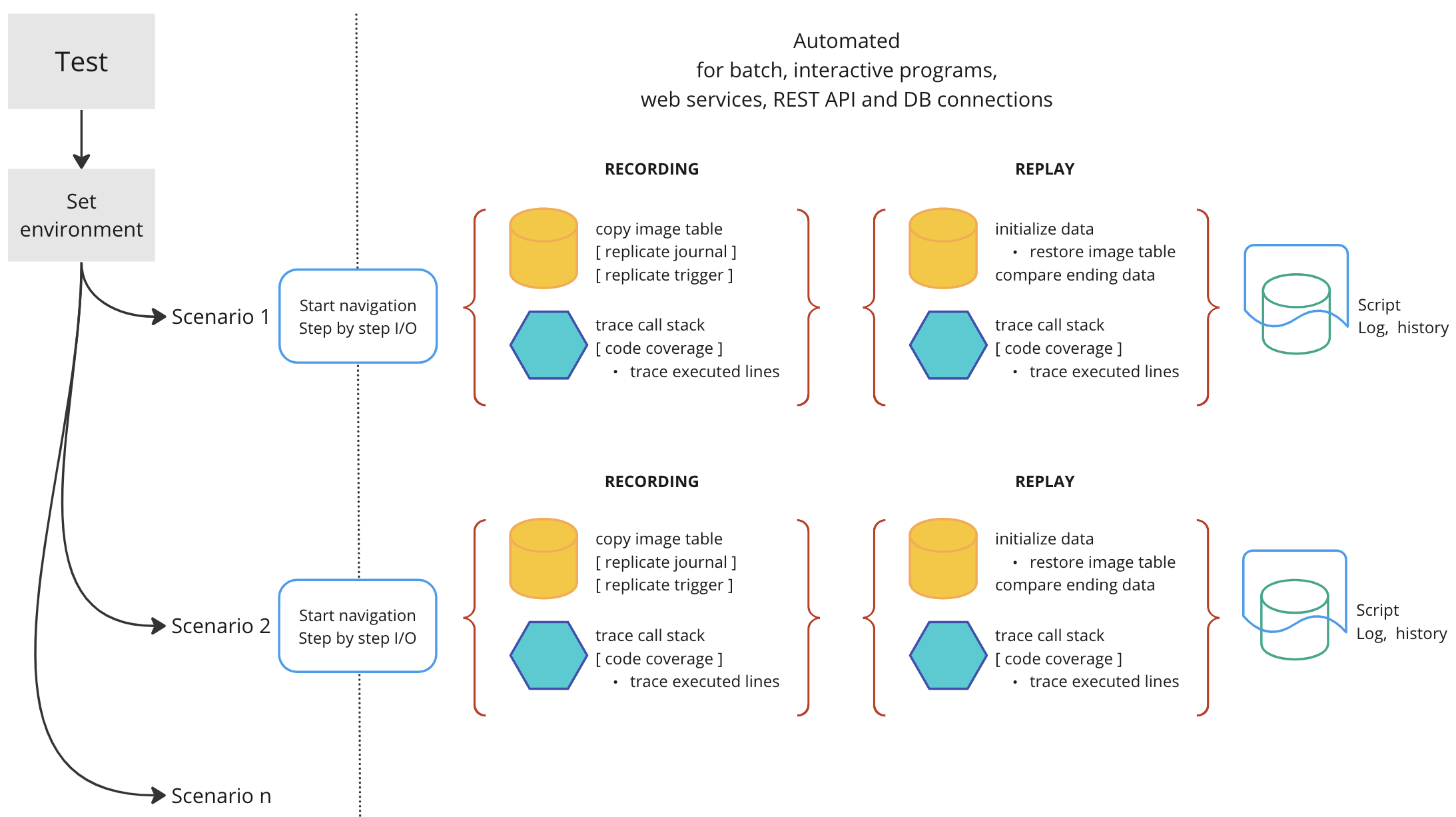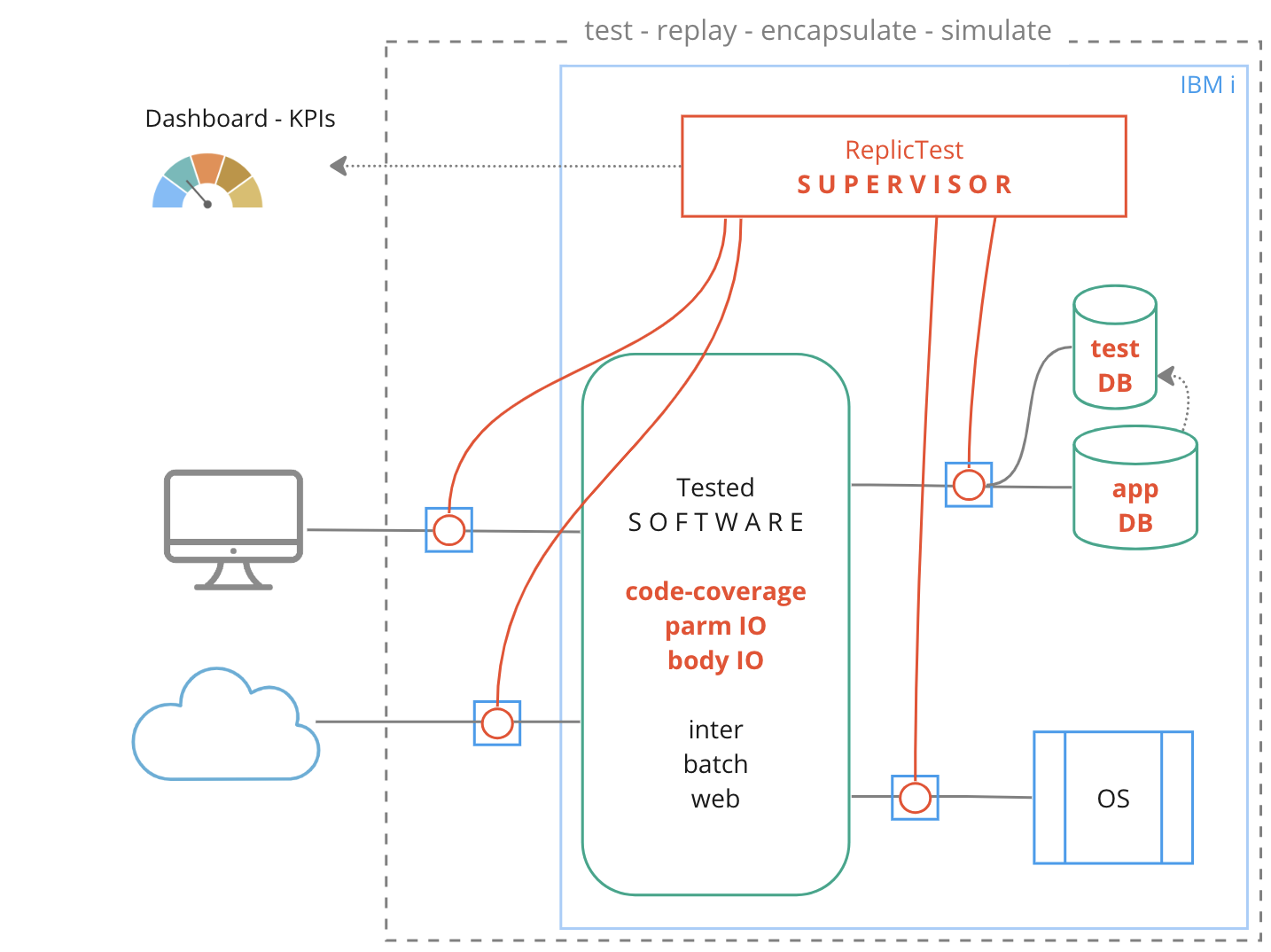Simplicity and efficiency are the predominant factors of this "engine" Testing tool for your IBM i applications
Native green screen 5250
Web Services
Application's DB tables
Code Coverage
Call pgm IO parm
Shrink Data
Enable & Automate your testing
Institutionalize quality and Save more than 88% of your time
Accelerate time to marketFull DataBase integration
DB tables and files identification for images, restore and comparison are automatically handled.
Tests need to be replicable, which means that the data must be reset each time a test is replayed and many test tools, like ours, include this functionality. But the prerequisite is that all data files or tables are identified first. This prerequisite is often left to the end user or some tools just copy entire libraries with all files and tables. ReplicTest does this automatically on the fly and only for the files and tables actually used by the specific test case. This is optimising all processes in your IBM i (aka AS400), from prerequisite recognition to execution, doing and automating all the hard tasks for you.

Automated for batch, web or interactive programs
The same command is used to process recording or replay of the test case. By default, the command automatically detects in which modality it should run; recording or playback and depending on the modality, different behaviors are processed to copy, restore or compare the image data.
Holistic
Comprehensive testing in a holistic manner with our Test Encapsulation Engine, inter/batch/web (encapsulating DB, UI, IO parm, body parm and code coverage – with restorations and comparisons)
Our “Encapsulation Engine” is “omnivorous”: It can also integrate any objects like spoolfiles dtaara, dtaq, IFS objects, the joblog, etc… and more, when you change an object in your system, you will know which tests involved it and relaunch all of them.
Invokable as a wrapper to single or series of Calls, REST APIs, SQL Requests.
Plugable to ACS, SQL Scripts, Cypress or Selenium.

Regression testing, deployment and monitoring
Tests can be scheduled automatically, in sequence or in parallel, with same or different login
Command driven, tests can be launched automatically via differents options, throught other commands or via scripts in modular ways.
Tests status are logged including call stacks. In case of failure, monitoring configuration can leave the job open, or end it (and go/no go to a next test), logging all relevants messsages and contextual metadata.
Switch login to test different user authority access can be truly undertaken. (ReplicTest integrates all objects ownership and authority in replay mode as well).
User experience, KPIs and improvement
The user experience has been valued, for instance with the flexibility of correcting Recordings already done. Imagine you recorded a test case involving 30 screens and you realize you’ve entered the wrong data on screen 25, the tool enables the flexibility to correct it without having to redo the all recording. The same goes for web services and the integration of body messages. Another example is with timestamps that can automatically be bypassed for test replay comparisons or as in the case of code coverage that can be retrieved dynamically through an SQL UDF and also in an automated test driven workflow.
Tasks can be divided between End-User and Programmer.
A non-programmeur end user can easily record a test case then a programmer can integrate it and deploy it.
Reporting can integrate a lot of information, from test status trends to message log with line statements, from code coverage percentage to time gained. All item information is available in a comprehensive database from which you can customize tests reporting.
At last, we can also obfuscate datasets and present results in a dashboard.

“Often, people ask what a realistic metric to measure design impact could be, and I’m convinced that metric is “time to value.” If your design influence isn’t decreasing overall time to value, you’re doing something wrong.”
Enable & Automate your testing
Watch the webinar to discover all the key features of a modern automated Testing solution for your IBM i applications
Integrate KPIs, Metrics and Trends into Your Software Development Lifecycle
Case Study
The tool enables a testing governance of high accuracy in correlation with impact analysis of lines of code to be changed for specific project like, for example Field Resize.
It is also totally integrable with our DevOps solution.


Empowered code coverage
Create test variations with the same initial data
User friendly and efficient
IDE or DevOps integration
Reviews
About our product: ECI’s EasyOrder is an IBM i web based e-commerce and order management solution and is used in a variety of industries. It covers the entire supply chain and the solution involves a variety of electronic procurement systems to purchasing systems with many customizations."
CONTACT US
Get in Touch!

FAQ
What is regression testing?
Regression testing (rarely, non-regression testing) is re-running functional and non-functional tests to ensure that previously developed and tested software still performs as expected after a change. If not, that would be called a regression.
What is end-to-end testing?
End-to-end testing is a software testing methodology that verifies the behavior and functionality of an entire application or system from start to finish. It focuses on testing the flow of data and processes across various components, subsystems, and interfaces, ensuring that the system works as intended and meets the desired requirements. In end-to-end testing, the system is tested as a whole, simulating real-world scenarios and user interactions to validate its functionality, performance, and reliability. It involves testing multiple interconnected modules or components to ensure seamless integration and proper functioning of the complete system.
Why is it often difficult to test an IBM i interactive application with 5250 screens?
Traditional 5250 screens are text-based and lack well-defined user interface elements. This can make it challenging to automate the testing process using conventional image pixel-based UI automation tools. Interacting with 5250 screens often requires emulating terminal input and capturing text-based output, which is automatically provided with our tool ReplicTest.
What is the ROI of testing in a digital transformation project?
In a development process, the test represents at least 20% of the budget and can go up to more than half of the established budget in certain cases.
As for the return on investment (ROI) of testing, this can be substantial in a digital transformation project. While the exact ROI will vary depending on the project and organization, here are several ways testing can contribute to ROI:
Early Issue Identification and Cost Reduction: Testing helps identify defects, bugs, or functional gaps early in the development process. By catching and addressing issues early, organizations can avoid costly rework, minimize the impact on downstream processes, and reduce the overall project costs.
Improved Customer Experience: Digital transformation projects often aim to enhance the customer experience. Through thorough testing, organizations can ensure that the transformed systems, applications, or interfaces provide a seamless, user-friendly experience. This can result in increased customer satisfaction, loyalty, and potentially higher revenue generation.
Reduced Downtime and Business Disruptions: Effective testing minimizes the risk of system failures, downtime, or disruptions during the transformation or after the go-live. By identifying and addressing potential issues in advance, organizations can avoid business interruptions, maintain operational continuity, and prevent revenue loss.
Enhanced System Performance and Scalability: Performance testing and load testing activities help identify and address performance bottlenecks, scalability issues, or potential limitations of the transformed system. Ensuring that the system can handle increased workloads or user demands improves overall system performance, user satisfaction, and the organization’s ability to handle growth.
Compliance and Risk Mitigation: Digital transformation projects often involve compliance with industry regulations, security standards, and data privacy requirements. Effective testing ensures that the transformed system meets these compliance needs, minimizing the risk of regulatory penalties, reputational damage, or legal issues.
Increased Efficiency and Productivity: Thorough testing helps identify areas for process improvement, automation opportunities, or usability enhancements. By streamlining workflows, eliminating manual tasks, and improving system efficiency, organizations can realize productivity gains, cost savings, and improved employee satisfaction.
Reduced Maintenance and Support Costs: Proper testing helps identify and rectify issues before the system goes into production. This can lead to a decrease in post-production support and maintenance costs as fewer defects or issues arise, resulting in improved system stability and reduced ongoing support efforts.
It’s important to note that the ROI of testing in a digital transformation project is influenced by various factors, such as the project’s scale, complexity, industry, and the effectiveness of the testing processes implemented. Organizations should consider these factors when planning and allocating resources for testing, aiming to maximize the ROI and ensure the successful outcome of the transformation project.

